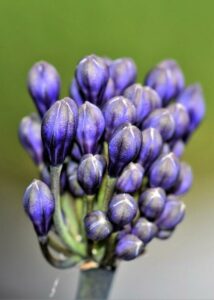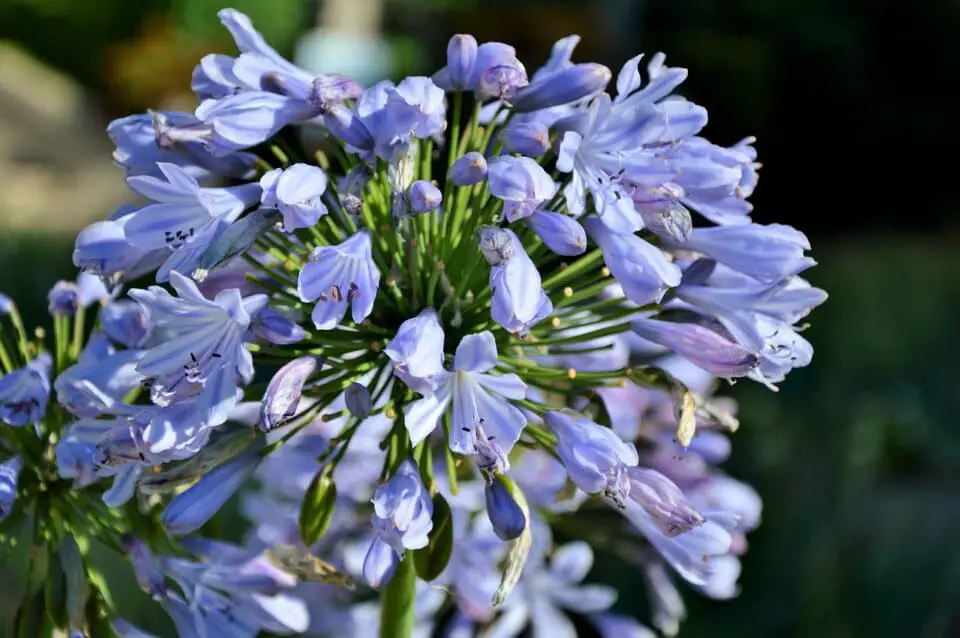Some links in the post are affiliate links and I get a commission from purchases made through some links found in the post.
Are your agapanthus leaves turning yellow? It’s easy to think that your plant is dying once you notice such a change. But before you do, assess the yellowing.
Is it affecting the mature leaves that are about to end their life cycle? If yes, the yellowing is just part of the plant cycle, and you can shrug them off. Or prune them, as I will detail in this guide.
However, if the agapanthus leaves are turning yellow before they mature, take this as a sign that something is not right. So, what could be the problem?
The leaves of an agapanthus plant over winter will naturally die back and turn yellow but if this is not the case then there could be other issues.
The other reason your agapanthus leaves are turning yellow could be due to rotting from the inside, infested with pests and diseases, underfed, or sunburnt.
I will get into the signs of all these issues and how you can step in and save your plant from what could be certain death.
Why Are Your Agapanthus Leaves Turning Yellow and How Can You Fix Them?
 The agapanthus, also known as the blue African Lily, is an easy plant to care for as it has reduced maintenance needs.
The agapanthus, also known as the blue African Lily, is an easy plant to care for as it has reduced maintenance needs.
I would even recommend it to a beginner who knows nothing about plant care. That’s how easy it is to keep this plant alive.
That said, it still has needs that you must meet. And whenever you fall short of the correct range, it starts dying, which first shows as yellowing of the leaves.
Please note that this is a serious problem – this plant, also called the African lily, depends on its leaves to make food to support its growth.
And when the agapanthus leaves are turning yellow, they lose chlorophyll and thus their ability to lose food. That spells impending doom. And the easiest way to reverse this issue is to nab the culprit and stop it in its tracks.
What could be the issue with your agapanthus?
1) You Have Overwatered It
Did you know that it’s possible to overwater an agapanthus? This perennial plant, native to Africa, enjoys hot climates and does well in USDA zones 8 to 10.
Due to the heat in such regions, you may feel the need to keep watering the plant to keep it cool. But you can go overboard by watering it when its soil is not dry enough or falling short on the below areas:
- Not giving the plant the right kind of drainage: The agapanthus does well in rich and well-draining soil. When the soil has a high water retention rate, it holds on to more moisture than the plant needs,
- Watering the plant when the top two inches of the soil are moist: The soil will already have enough moisture at this point, and adding more would only take up more air packets, depriving the roots of oxygen,
- Growing the plant in a pot with inadequate drainage holes, thus preventing the excess water from draining.
- Not providing enough room for air circulation around the plant, thus enabling moisture to sit in the soil,
- Creating a highly humid environment that fosters fungal diseases.
What happens when you do any of these things? The roots end up sitting in the water, unable to access oxygen, and they start dying.
At first, you notice that the leaves have become swollen, then you notice that they have started yellowing. Moreover, this exposure to oxygen-deprived water creates the right environment for agapanthus diseases to exhibit.
These include root rot, leaf spot, and anthracnose, which result in yellow and brown spots on the leaves and stems. The leaves then start falling off the plant.
If you ignore these signs, root damage continues until the roots become soggy and mushy, unable to support the plant, and the plant dies.
Can You Stop Overwatering?
Yes! All you need is to understand the cause behind the overwatering and fix it as follows:
- Overwatering the plant by giving it too much water: You should always check the state of the soil by digging two inches into the soil surface. Only water the plant when these inches are dry. If you have difficulty gauging the moisture in the soil, get a moisture gauge and save yourself the guesswork.
- Drainage issues: You can either replace the pot or poke more holes into the current pot. If the holes are clogged with dirt, you can try widening them to keep this from happening. You are better off with too much drainage than too little of it.
- A high-water retention rate: You can add perlite to the soil and avoid adding compost for a while. The goal is to achieve a medium texture that allows more water to flow through the soil.
- Poor air circulation: Leave the plant in a room where air flows freely. Preferably, place it near a window or door so it can access the drafts. But do not leave it under heating or cooling vents.
- High humidity: You can move the plant to a cooler room where the humidity is not as high. Aim for moderate humidity, and don’t go too low as this can trigger browning.
What if the plant has suffered root rot and other fungal diseases? You will need to cut off the affected root parts using a sharp and sterile tool and treat the remaining parts with fungicide.
Then repot the plant in a fresh potting mix in a well-draining pot and follow a rigid watering schedule to avoid similar issues.
You may also like: How to care for an agapanthus in the winter
2) You Have Left it in the Direct Sun
Can your agapanthus get sunburnt? Of course! While this plant can do well in the full sun, it prefers 6 hours of bright and indirect light.
As the seasons get hotter, the full sun becomes a bit too much for the plant. And in the higher USDA zones, the leaves can suffer damage. How can you tell that this is the case?
- The plant’s leaves appear wilted,
- The plant looks droopy,
- The leaves yellow,
- The leaves turn crispy and fall off the plant.
These are signs that the plant cannot keep up with the current levels of light. And sometimes, it can also mean that the plant does not have adequate water.
But if the soil is slightly moist and the plant still behaves like this, you should consider moving it.
Dealing with Sunburn
 Sunburn is irreversible, and the only thing you can do is prevent the new leaves from getting burned. How?
Sunburn is irreversible, and the only thing you can do is prevent the new leaves from getting burned. How?
You should move your plant to a spot where it gets bright and indirect light – this is the light you would get near an east or west-facing window.
Avoid south, and north-facing windows as these have too much or too little sun exposure, depending on your hemisphere.
The plant should not receive direct noon or afternoon sunlight as this is too harsh. Instead, you can allow it to receive the morning sun and shield it from the afternoon rays.
Also, ensure you keep the plant watered, especially in the summer. And occasionally mist it if it shows signs of low humidity.
3) You Have Not Fed It Enough
Interestingly, agapanthus plants bloom better if you leave them slightly unfed. But sometimes, people mistake this slight underfeeding for low feeding.
They are not the same. When you do not feed your plant enough, it lacks two key nutrients – iron and nitrogen. Iron is essential in making chlorophyll, and in its absence, yellowing starts to show.
Nitrogen deficiency also results in yellowing, only that it shows along the edges of the leaves. Should you worry about this deficiency? Yes- without chlorophyll, your plant cannot make food and can thus not produce blooms.
How Should You Feed Your Plant?
You should give your plant a good feeding towards the start of spring using a weak liquid fertilizer. And keep doing it until the plant starts flowering. You can then stop and allow the plant to survive on that until the next spring.
How about these deficiencies? The first thing to do is to test the soil for deficiencies. You may think that the soil needs a given nutrient, yet it does not.
If the soil turns out to be iron-deficient, you can add alfalfa or poultry blood meal to it. And if nitrogen deficiency is to blame, you can use a nitrogen feed or add compost and other organic materials.
4) You Have Left It Vulnerable to Pests
Guess what – the above issues leave your plant weak and exposed to pests.
These attack vulnerable plants, sucking the sap out of them, further weakening them, and exposing them to diseases. Pests that attack agapanthus plants include:
- Spider mites, and
- mealy bugs
Dealing with Pests
You can ward off pests by ensuring your plant is well-fed, well-watered, and not exposed to the direct sun.
But if an infestation has already presented, you cannot ignore it, as doing so would leave the plant vulnerable to further damage.
Instead, you must use insecticides (chemical or natural) on the affected parts to eliminate the pests before they spread. Afterward, you can spray the plant with neem oil to keep pests away from it.
You may also like: 5 great planting combinations with your agapanthus
Should I Cut Yellow Leaves Off Agapanthus?
Agapanthus plants rely on their leaves to make food. When the leaves reach a mature stage, they yellow and brown before falling off the plant.
They then decompose and feed the resultant nutrients to the plant. Thus, you can allow the yellowed leaves to remain on the plant where they can complete the life cycle. However, you can cut them off if:
- The plant is in its blooming stage, and the leaves have yellowed owing to any of the issues covered above: In this case, the yellowing owes to damage, and the plant will spend its energy trying to heal the leaves. This focus will rob the plant of the ability to sustain its flowering, and the blooms will suffer. You would be right to cut off the yellow leaves.
- The yellow leaves are unsightly, and you would prefer to enjoy the plant without them: Most people just want to gaze at the flowers which appear in the late spring to summer. And they do not want to deal with the effects of sun or water damage. You don’t need to keep the yellow leaves on the plant.
- The leaves have yellowed due to pest infestation: The best way to keep pests away is to remove any damaged plant parts to avoid spreading the infestation. Moreover, you must follow through with offering the plant enough water, light, and nutrients to ensure the pests stay away from your agapanthus.
So, how can you cut off the leaves? Easy! All you need is a sharp knife or a pair of scissors. Ensure that you sterilize the tool before using it on the plant.
Else, you will only spread infections to the plant. Also, when dealing with a diseased plant, you should sterilize the tool each time you use it on the plant.
You must also use a sharp tool that will cut through the plant easily without bruising the surrounding tissue. Once you have such a tool, move through the plant, cutting off the yellow leaves at their bases.
Do not cut away too many leaves too soon, as this can refocus the plant’s energy on foliage production rather than blooming.
Can Agapanthus Leaves Recover from Turning Yellow?
 Yellow leaves are not quite what you want, contrasting the lovely blue flowers on your agapanthus. But as we have seen, they can result from many issues, including overwatering.
Yellow leaves are not quite what you want, contrasting the lovely blue flowers on your agapanthus. But as we have seen, they can result from many issues, including overwatering.
Can you revert the damage to the leaves? Unfortunately, most problems that cause yellowing are irreversible. Take sun damage as an example.
When your plant’s leaves suffer sunburn, there is nothing you can do to change their color. You can wait for them to fall off or cut them off and enjoy new foliage under better light.
You also cannot undo the agapanthus leaves turning yellow that arises from pest infestation or overwatering, as these are issues that kill the plant from within. Or you can change the conditions under which the plant grows, and its new leaves will come out green.
Want to hear the good news? You can reverse yellowing that owes to nutrient deficiency. When chlorosis is in play, you need to amend the soil, and the leaves will soon start producing chlorophyll.
However, this is not always a guarantee, and you may still have yellow leaves where the damage was extensive.
Final Thoughts
The agapanthus is not such a demanding plant. If you can keep it in slightly moist soil, away from direct sunlight, and well-fed, you can avoid pest and disease infestations.
And you can avoid yellowing and other related problems for a very long time. It might seem overly simplified, but that’s the truth about growing a beautiful African lily.
Happy Gardening!

